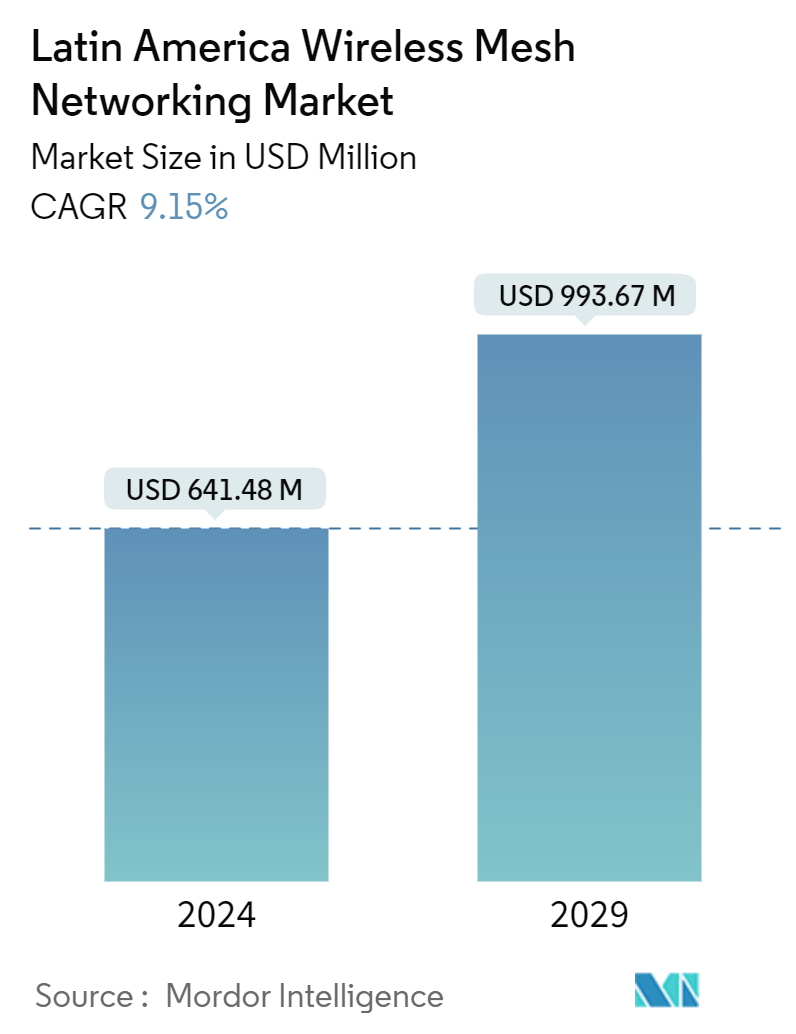Market Size of Latin America Wireless Mesh Networking Industry

| Study Period | 2019 - 2029 |
| Base Year For Estimation | 2023 |
| Market Size (2024) | USD 641.48 Million |
| Market Size (2029) | USD 993.67 Million |
| CAGR (2024 - 2029) | 9.15 % |
| Market Concentration | Low |
Major Players
*Disclaimer: Major Players sorted in no particular order |
Latin America Wireless Mesh Networking Market Analysis
The Latin America Wireless Mesh Networking Market size is estimated at USD 641.48 million in 2024, and is expected to reach USD 993.67 million by 2029, growing at a CAGR of 9.15% during the forecast period (2024-2029).
The surge in the market is primarily driven by the rising adoption of wireless mesh networks, which are favored for their reliable capabilities, offering faster data transmission and simplified deployment.
The market is propelled by the increasing integration of advanced technologies like the Internet of Things (IoT) and the advent of 5G networks. This confluence of advancements reshapes connectivity paradigms, marking a significant shift in how industries connect in the digital era and deploy wireless mesh networking devices to meet the needs.
By April 2024, 29 operators in Latin America, spanning 10 countries, had introduced commercial 5G services. Additionally, several operators have outlined plans to launch their own 5G services in the near future. This surge will be fueled by launching new 5G markets and expanding existing networks into previously uncovered regions. According to the GSMA report, 5G is poised to dominate, constituting nearly 60% of all mobile connections in Latin America by 2030.
Transitioning to cloud-native infrastructure is pivotal for facilitating 5G standalone (5G SA) rollouts. While Latin America, like much of the world, has predominantly adopted a non-standalone (NSA) approach for its initial 5G deployments, Brazil stands out with its emphasis on 5G SA networks. Nonetheless, the rest of the region is poised to witness a surge in 5G SA availability. According to GSMA Intelligence, 55% of Latin American operators already operating 5G networks have committed to transitioning to 5G SA, following the global trend.
Wireless mesh networking is crucial in developing innovative city applications, including intelligent traffic management, environmental monitoring, and bright lighting. Fira de Barcelona awarded Brazil as the Smart City of 2023 at the World Smart City Awards gala held at the Smart City Expo World Congress (SCEWC) to appreciate innovative initiatives and projects in the urban transformation industry. Cities such as Santiago (Chile) and Sao Paulo (Brazil) are investing in technologies to enhance urban living, which is driving the growth of the market studied.
The high initial costs and maintenance expenses restrict the integration of wireless mesh networking, especially in rural areas. It is heavily dependent on government grants, international aid, or public-private partnerships, which create challenges for the market to prosper in every area of Latin America.
Post-COVID-19 has accelerated the need for reliable and widespread internet connectivity. There is a shift toward online education and hybrid work models, which require an advanced wireless mesh networking system to cater to the growing needs. Many countries in Latin America are investing in advanced networking systems for smart city projects to support IoT devices in these projects.
Latin America Wireless Mesh Networking Industry Segmentation
The report on the Latin American wireless mesh networking market tracks the revenue generated by the sale of mesh networking systems and devices (such as mesh routers, extenders, gateways, and clients) provided by market vendors to various end users across Latin America.
The Latin American wireless mesh networking market is segmented by end-user type [(consumers and enterprises (small and medium-sized enterprises and large enterprises)] and country (Brazil, Mexico, Argentina, Colombia, and Rest of Latin America).
The market sizes and forecasts are provided in terms of value (USD) for all the above segments.
Latin America Wireless Mesh Networking Market Size Summary
The Latin America wireless mesh networking market is experiencing significant growth, driven by the increasing adoption of advanced technologies such as the Internet of Things (IoT) and the rollout of 5G networks. These technologies are reshaping connectivity paradigms, enabling faster data transmission and simplified deployment of networking solutions. The market is further propelled by the demand for reliable and widespread internet connectivity, particularly in urban areas where smart city initiatives are gaining momentum. Cities like Santiago and Sao Paulo are investing in these technologies to enhance urban living, which is contributing to the market's expansion. However, the high initial costs and maintenance expenses of wireless mesh networking systems pose challenges, especially in rural regions, where government support and public-private partnerships are often necessary to drive adoption.
Brazil stands out in the region with its focus on 5G standalone networks and smart city projects, which are fostering the growth of wireless mesh networking. The country's commitment to digital transformation and sustainability is evident in its urban planning and environmental initiatives, such as those in Curitiba. The Brazilian market is also witnessing significant investments in advanced networking technologies, with key players like Motorola Solutions, Cisco Systems, and Qualcomm leading the charge. These companies are actively involved in product innovation and strategic collaborations to enhance their market presence. The competitive landscape is further shaped by partnerships and technological advancements, such as Qualcomm's micro-power WiFi SoC and ASUS's next-gen mesh routers, which are set to elevate connectivity solutions across the region.
Latin America Wireless Mesh Networking Market Size - Table of Contents
-
1. MARKET INSIGHTS
-
1.1 Market Overview
-
1.2 Analysis of Macro-Economic Scenarios (Recession, Russia-Ukraine Crisis, etc.)
-
1.3 An Assessment of the Impact and Recovery from COVID-19
-
-
2. MARKET SEGMENTATION
-
2.1 By End-user Type (Market Estimates, Forecast, Trends and Other Market Dynamics)
-
2.1.1 Consumers (Residential)
-
2.1.2 Enterprises (Commercial, Industrial, Government)
-
2.1.2.1 Small and Medium-sized Enterprises
-
2.1.2.2 Large Enterprises
-
-
-
2.2 By Country (Market Size Estimates & Forecast, Trends, and Other Market Dynamics)
-
2.2.1 Brazil
-
2.2.2 Mexico
-
2.2.3 Argentina
-
2.2.4 Colombia
-
-
Latin America Wireless Mesh Networking Market Size FAQs
How big is the Latin America Wireless Mesh Networking Market?
The Latin America Wireless Mesh Networking Market size is expected to reach USD 641.48 million in 2024 and grow at a CAGR of 9.15% to reach USD 993.67 million by 2029.
What is the current Latin America Wireless Mesh Networking Market size?
In 2024, the Latin America Wireless Mesh Networking Market size is expected to reach USD 641.48 million.

